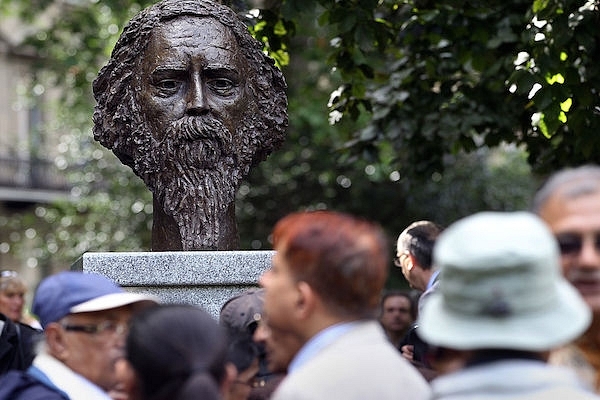Magazine
Different Strokes
- Even if some great writers are missing from The Greatest Bengali Stories Ever Told, it is still one to read and enjoy, and learn about the vast range of the Bengali short story.

Photo: ADRIAN DENNIS/AFP/Getty Images
Rabindranath Tagore left a deep impression on Bengali literature and it took a long time for Bengali literature to transcend the Tagore influence and move beyond. I am not sure if other Bengalis will agree, but I think short stories were fairly quick in transcending the Tagore influence, though, in a way, Tagore was responsible for the genre being created.
There have been many short story writers. In fairness to Arunava Sinha, he states in his introduction, “I must make clear though that this is not a selection based on literary eras, canons, trends, or any other form of critical sieving. Nor is it meant to be a representative cross section of the Bengali short story. These are, simply, stories I have loved and that have made a deep impression on me.” There is subjectivity in the choice, stated explicitly. Otherwise, for any such anthology, one would ask two questions.
First, is the cross section representative? Have all the better short story writers been included?
I showed this book to a friend who knows much more about Bengali literature than I do, since he writes Bengali fiction himself. We compared notes and agreed on some missing names we would have included had we done the compilation: Manik Bandopadhyay, Parashuram (Rajshekhar Basu), Kamal Kumar Majumdar, Shibram Chakrabarti, Saradindu Bandopadhyay, Subodh Ghosh, Narayan Gangopadhyay, Lila Majumdar and Shirshendu Mukhopadhyay. (We didn’t agree on Samaresh Basu.)
Sinha has 21 authors/ stories: Rabindranath Tagore, Pramatha Chaudhuri, Sarat Chandra Chattopadhyay, Bibhutibhushan Bandyopadhyay, Tarashankar Bandhyopadhyay, Banaphool (Balai Chand Mukhopadhyay), Premendra Mitra, Buddhadev Bose, Ashapurna Debi, Narendranath Mitra, Satyajit Ray, Ramapada Chowdhury, Ritwik Ghatak, Mahasweta Devi, Moti Nandy, Sandipan Chattopadhyay, Udayan Ghosh, Sunil Gangopadhyay, Sanjib Chattopadhyay, Nabarun Bhattacharya and Amar Mitra. A priori, the only surprise on this list is Ritwik Ghatak. Otherwise, barring exclusions, these are expected names. Given that subjectivity is explicitly mentioned, one can’t complain about the exclusions either. Suffice to say, the included list cuts across generations.
Second, once you have included an author, which of his or her stories do you pick? Take Tagore. The story included is “The Kabuliwallah”. Tagore wrote many short stories. “The Kabuliwallah” is one of the earlier ones. It might be one of the more famous ones from the point of view of a non-Bengali readership, but it is certainly not Tagore’s best. What I have said about Tagore is also true of the other authors included. For many (not all), I can think of better stories. But then, Sinha disarms you with the statement that these are ones that he loves.
This is not Sinha’s first attempt at translating from Bengali (fiction and non-fiction) into English. He has done it for many years and some of his translated books have won awards. Therefore, you shouldn’t be surprised if I tell you that the translations are good.
However, having read them, I wondered about something else. Even if the language is the same, the nature of prose written by one person is different from that written by another. Is Nirad Chaudhuri’s language the same as that of R.K. Narayan’s? Similarly, the texture of Bibhutibhushan Bandyopadhyay’s Bengali is distinct from that of Satyajit Ray’s. But this is impossible to capture in a translation, if the same person is doing the translation. Sinha’s English is the same, irrespective of who the original Bengali author was. The issue didn’t arise when Arunava translated only Anita Agnihotri’s stories or Sankar’s Chowringhee. Those were single authors, but this is an anthology.
There isn’t a simple solution to this problem. There is probably none. For non-Bengalis, this is an excellent compilation, excellent because of the quality of translation and because, if one reads all of the stories, one gets a very good idea of how the Bengali short story has evolved (Bengalis, or non-Bengalis who read Bengali, will read them in Bengali). There is an introduction that is not called an introduction. It is titled, “My love affair with Bengali stories”. Though this is a personal take, there is a brief sketch of how the genre has evolved.
Do read the book. You will enjoy it. If Sinha plans a sequel, perhaps he can consider some of the writers my friend and I listed.
Introducing ElectionsHQ + 50 Ground Reports Project
The 2024 elections might seem easy to guess, but there are some important questions that shouldn't be missed.
Do freebies still sway voters? Do people prioritise infrastructure when voting? How will Punjab vote?
The answers to these questions provide great insights into where we, as a country, are headed in the years to come.
Swarajya is starting a project with an aim to do 50 solid ground stories and a smart commentary service on WhatsApp, a one-of-a-kind. We'd love your support during this election season.
Click below to contribute.
Latest